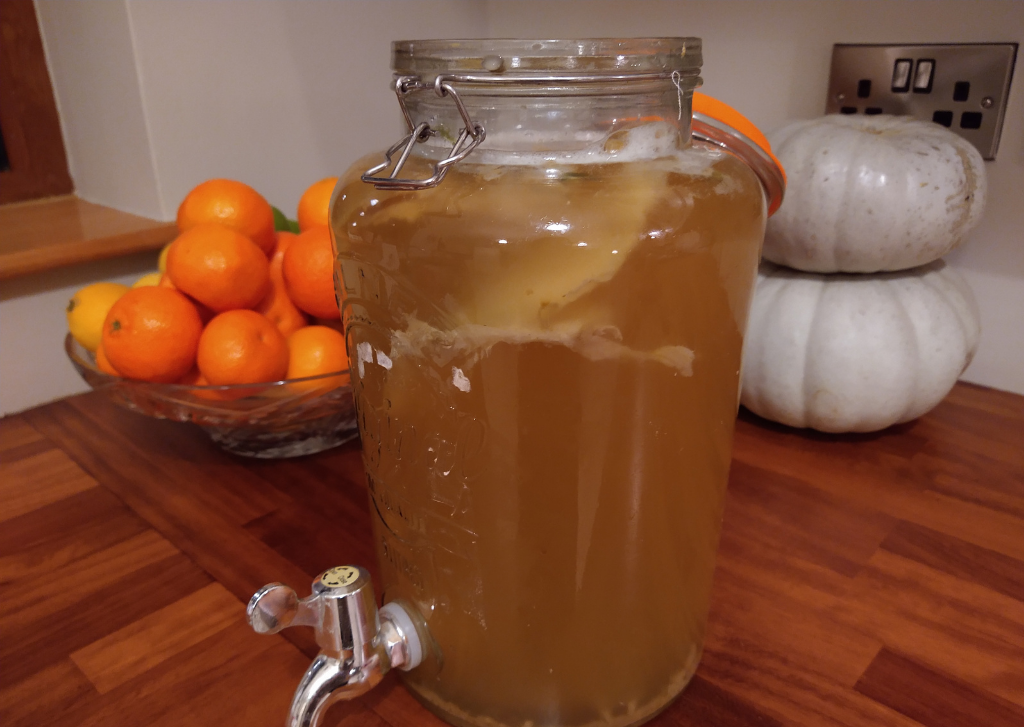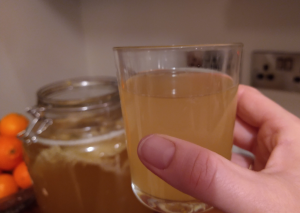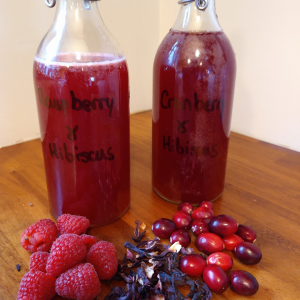Fizzy kombucha is a great replacement for other sweet or alcoholic drinks, while supporting gut health along the way. It is really simple to make, and by adding in a second fermentation step you can really take the taste to the next level and use it as a replacement for those alcoholic drinks at festive occasions.
What is Kombucha?
Kombucha is a sparkling, cultured, probiotic drink made from regular black or green tea and contains beneficial lactic acid bacteria. It is fermented using a SCOBY, or a Symbiotic Culture Of Bacteria and Yeast. This SCOBY feeds of the sugar that has been added to the tea, leaving behind beneficial lactic acid bacteria. You can buy this ready made in a Health food shop, but it’s so easy to make at home and so much cheaper if you drink a lot of it.
Get Fermenting
To make kombucha you first need a scoby. You can get a scoby from someone you know that is already making kombucha, as a new scoby is made with every batch. Or if, like me, you don’t know anyone making it you can buy a scoby from here. Or you can have a look at this group on Facebook if you are within Ireland, all you would need is to pay for postage.
The teas that are generally used are green or black teas. It’s best not to use a flavoured tea, as the oils from the herbs or flowers can interfere with the fermentation and damage the scoby, but these can be added for a second ferment. The green tea I use is Green Snail tea from House of Tea. I find this makes a really light tea, and my children much prefer this to the darker kombucha made from black tea. You can also make the kombucha using a mixture of green and black teas. When picking teas go for high quality, organic teas where possible.
When starting off it’s probably best to start with low volumes until the scoby gets used to its new environment and you get used to the process. The recipe I’ve given below is per litre of tea, you can multiply this up to whatever volume you want to make.
You will need:
- A large bowl
- Plastic strainer
- Tea – if using lose tea 1 heaped tablespoon per litre. If using tea bags 2 teabags per litre.
- 60g of organic sugar per litre
- Boiling water
- A 2L -5L glass jar depending on how much you are making.
- A scoby, along with 250ml of the donating persons last kombucha brew (or 250ml of shop-bought brew)
- 2 x 750ml or 4 x 350ml glass bottles with airtight caps
Method:
- Boil the kettle and sterilise the glass jar with some boiling water and air dry
- Make the tea by adding boiling water to the tea. NOTE: Be sure to only make half the volume of tea you actually need. We will top up with cold water to the required volume to cool it down.
- Mix in the sugar, mix to dissolve and allow to brew for 10-15 minutes
- Strain into the glass jar. Top up the tea to the final volume minus 250ml with cold water. For example, if I was making 2 litres I would top up the tea to 1.75 litres with cold water.
- Once the tea is cool, add the 250ml of the previous kombucha (that either came with the scoby, or from your previous batch). This helps to sterilise the tea so that no nasties will grow in the brew.
- Cover the jar with a piece of cloth or an old tea towel, securing with a rubber band. This will allow your scoby to breathe as it needs air to survive.
- Place the brew in a cool place, away from direct sunlight and allow to ferment for 7-14 days. The time needed will depend on the weather, the size of the scoby and the volume of liquid you are trying to brew. If it is warm it will take less time than if it is cooler. You can start tasting it at day 7 to see if it is ready. This also depends on your taste preference. If it is too sweet, you can leave it longer. But if it has become too vinegar-ish it has gone too far so taste it daily. If you are unsure, purchase a small bottle of plain kombucha from your local health food shop and compare the taste (but bear in mind these can sometimes be a little sweeter!). During the fermenting process you will notice that a new scoby has begun to grow and bubbles may form on the surface. You can give this new scoby to a friend in 1 cup of your brew, or you can leave it to grow on your own scoby. The bigger the scoby gets the faster the fermentation becomes. Or you can throw it out.
- When the kombucha is ready to your liking you can now bottle it. Always leave 250ml for your next ferment. If you have enough kombucha for your needs, or you are going away, you can leave the scoby in 500ml of kombucha in a bowl in the fridge. When you are ready to start again, just take it out and add to another batch of sweetened tea.
- Your kombucha is now ready to drink, or you can flavour it by doing a second ferment! Start slowly by having just 15ml/day with food and increase over 1 week to 50ml/day. If having it as a daily drink, our digestive system needs time to adjust to the new bacteria, which could be in very high levels. After one week you may want to increase it, or have it several times in the day. You can drink occasionally, but this is all that is needed for daily maintenance.
THE SECOND FERMENT – TO MAKE IT FIZZY
While you can drink the kombucha straight from the first ferment, you can also flavour it to add different tastes and effervescence. This process generally takes just 3 days. It’s probably best to start with plastic bottles, as the effervescence can build up quickly depending on what’s added and the temperature of the house. You don’t want exploding bottles! Once you have the hang of it, you can use glass bottles with an air-tight lid.
- Once you have removed your scoby and one cup of your brew, give the rest of the brew a good stir, ensuring you stir up any sediment on the bottom of the jar. Transfer your brew to a second jar, or plastic bottle with an airtight lid.
- For the extra flavours you can add anything you like. For my festive second ferments I have added 1 heaped teaspoon of hibiscus flowers to every 500ml. This gives it that bright red colour. For added sweetness I added 1 tablespoon of raspberries. To another I added 1 tablespoon of cranberry juice. Ginger is another great flavour to add, and it will really increase the effervescence, so watch out!
3. Place the lid on tightly and leave in a cool place, away from direct sunlight, for a further 3 days.
4. Using a funnel, strain your kombucha into the smaller bottles (make sure these have been sterilised with boiling water and allowed to cool). Place the caps on nice and tight and place them in the fridge.
CAUTION: Kombucha may contain between 0.5%-3% alcohol. The longer it is brewed and the more sugar it contains, the higher the alcohol content. If you practice strict alcohol abstinence kombucha is not for you. If you are pregnant you should limit your intake accordingly.
Troubleshooting
What is normal?
- It is normal to have some brown stringy things hanging of the bottom of your scoby.
- It is normal to have a cloudy layer begin to form on the top of the liquid during the first fermentation. This is the beginning of the formation of a new scoby. By the end of the first fermentation you will have grown a baby scoby. This is what you can donate to someone else if you like. Or you can start a second brew going. If you don’t need it you can throw it out. Or if you want to slow down the brewing process of your next batch, you can use the new scoby and throw the big one out. Up to you.
- It’s normal to have some holes appearing in the scoby from time to time.
What is NOT normal?
Furry mould of any colour growing on the top of your brew or scoby at any time is NOT normal. If this occurs ditch the whole thing, get a new scoby and start again. Don’t be discouraged. Sterilising all equipment with boiling water and allowing it to air dry, and following this recipe as close as you can, will limit the chance of it happening again.
Be Creative
Once you have mastered the basic technique above, are making successful brews and are happy with the taste you can experiment with different teas. As mentioned above, it’s best to stay away from teas that are flavoured such as Yasmin green tea or Earl grey for example, as these may kill your scoby. Oolong, English breakfast and White tea all make for interesting variations. Black tea is the best to start with, but you can try using half and half black tea and green tea, or 100% green tea for a lighter taste like I prefer.
You can add herbal teas, in addition to the basic tea to add another layer of flavour to the brew. Hibiscus is a common one that will give you a deep red colour. You need to add a larger quantity of herbals to taste them – start with 6 teaspoons per 1.5L and see if the taste comes through!
Have you made fizzy kombucha before? What are you favourite second ferments? Let me know in the comments below
↓ PIN FOR LATER ↓






0 Comments